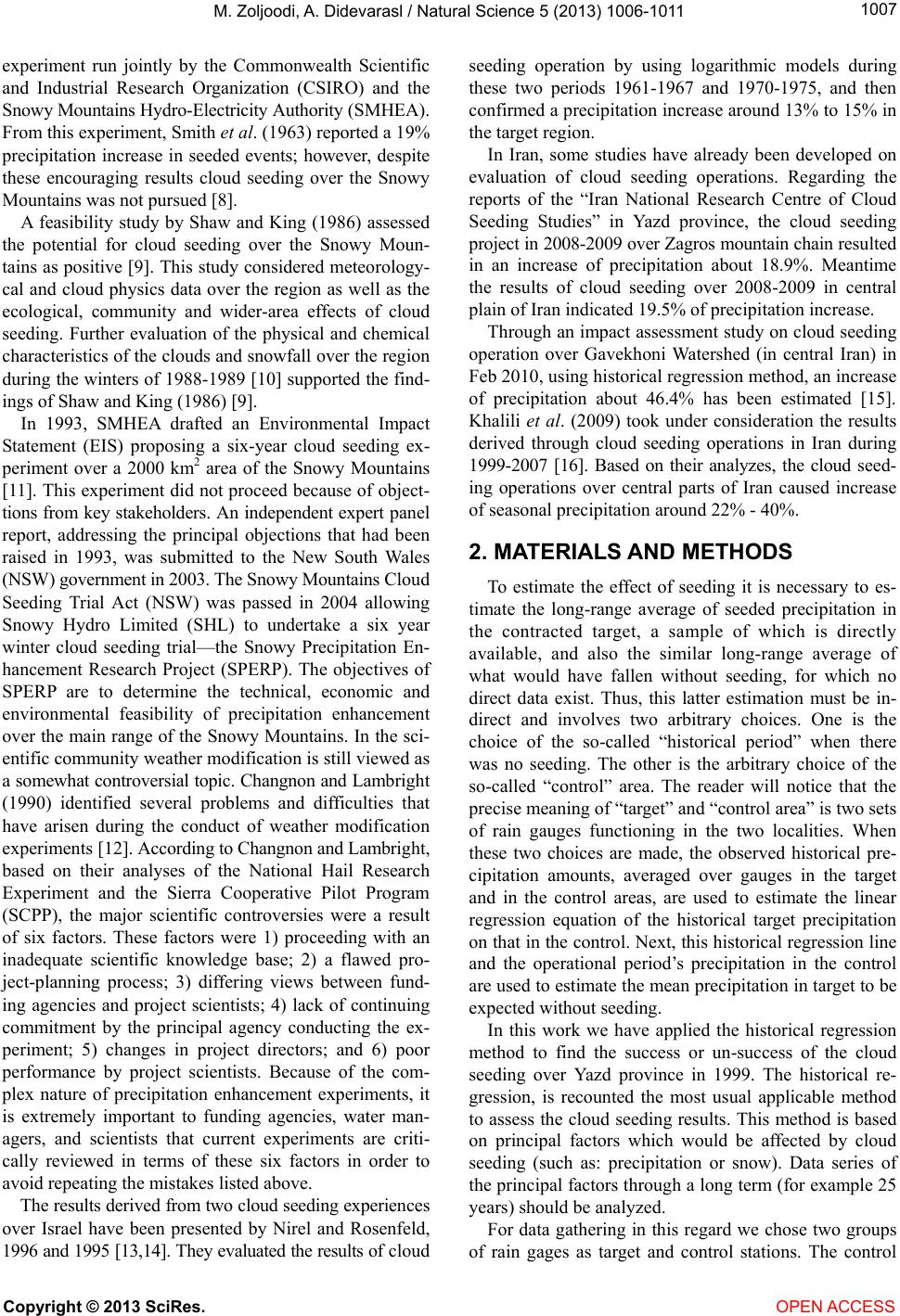
M. Zoljoodi, A. Didev arasl / Natural Science 5 (2013) 10 06-1011 1007
experiment run jointly by the Commonwealth Scientific
and Industrial Research Organization (CSIRO) and the
Snowy Mountains Hydro-Electricity Authority (SMHEA).
From this experiment, Smith et al. (1963) reported a 19%
precipitation increase in seeded events; however, despite
these encouraging results cloud seeding over the Snowy
Mountains was not pursued [8].
A feasibility study by Shaw and King (1986) assessed
the potential for cloud seeding over the Snowy Moun-
tains as positive [9]. This study considered meteorology-
cal and cloud physics data over the region as well as the
ecological, community and wider-area effects of cloud
seeding. Further evaluation of the physical and chemical
characteristics of the clouds and snowfall over the region
during the winters of 1988-1989 [10] supported the find-
ings of Shaw and King (1986) [9].
In 1993, SMHEA drafted an Environmental Impact
Statement (EIS) proposing a six-year cloud seeding ex-
periment over a 2000 km2 area of the Snowy Mountains
[11]. This experiment did not proceed because of object-
tions from key stakeholders. An independent expert panel
report, addressing the principal objections that had been
raised in 1993, was submitted to the New South Wales
(NSW) government in 2003. The Snowy Mountains Cloud
Seeding Trial Act (NSW) was passed in 2004 allowing
Snowy Hydro Limited (SHL) to undertake a six year
winter cloud seeding trial—the Snowy Precipitation En-
hancement Research Project (SPERP). The objectives of
SPERP are to determine the technical, economic and
environmental feasibility of precipitation enhancement
over the main range of the Snowy Mountains. In the sci-
entific community weather modification is still viewed as
a somewhat controversial topic. Changnon and Lambright
(1990) identified several problems and difficulties that
have arisen during the conduct of weather modification
experiments [12]. According to Changnon and Lambright,
based on their analyses of the National Hail Research
Experiment and the Sierra Cooperative Pilot Program
(SCPP), the major scientific controversies were a result
of six factors. These factors were 1) proceeding with an
inadequate scientific knowledge base; 2) a flawed pro-
ject-planning process; 3) differing views between fund-
ing agencies and project scientists; 4) lack of continuing
commitment by the principal agency conducting the ex-
periment; 5) changes in project directors; and 6) poor
performance by project scientists. Because of the com-
plex nature of precipitation enhancement experiments, it
is extremely important to funding agencies, water man-
agers, and scientists that current experiments are criti-
cally reviewed in terms of these six factors in order to
avoid repeating the mistakes listed above.
The results derived from two cloud seeding experiences
over Israel have been presented by Nirel and Rosenfeld,
1996 and 1995 [13,14]. They evaluated the results of cloud
seeding operation by using logarithmic models during
these two periods 1961-1967 and 1970-1975, and then
confirmed a precipitation increase around 13% to 15% in
the target region.
In Iran, some studies have already been developed on
evaluation of cloud seeding operations. Regarding the
reports of the “Iran National Research Centre of Cloud
Seeding Studies” in Yazd province, the cloud seeding
project in 2008-2009 over Zagros mountain chain resulted
in an increase of precipitation about 18.9%. Meantime
the results of cloud seeding over 2008-2009 in central
plain of Iran indicated 19.5% of precipitation increase.
Through an impact assessment study on cloud seeding
operation over Gavekhoni Watershed (in central Iran) in
Feb 2010, using historical regression method, an increase
of precipitation about 46.4% has been estimated [15].
Khalili et al. (2009) took under consideration the results
derived through cloud seeding operations in Iran during
1999-2007 [16]. Based on their analyzes, the cloud seed-
ing operations over central parts of Iran caused increase
of seasonal precipitation around 22% - 40%.
2. MATERIALS AND METHODS
To estimate the effect of seeding it is necessary to es-
timate the long-range average of seeded precipitation in
the contracted target, a sample of which is directly
available, and also the similar long-range average of
what would have fallen without seeding, for which no
direct data exist. Thus, this latter estimation must be in-
direct and involves two arbitrary choices. One is the
choice of the so-called “historical period” when there
was no seeding. The other is the arbitrary choice of the
so-called “control” area. The reader will notice that the
precise meaning of “target” and “control area” is two sets
of rain gauges functioning in the two localities. When
these two choices are made, the observed historical pre-
cipitation amounts, averaged over gauges in the target
and in the control areas, are used to estimate the linear
regression equation of the historical target precipitation
on that in the control. Next, this historical regression line
and the operational period’s precipitation in the control
are used to estimate the mean precipitation in target to be
expected without seeding.
In this work we have applied the historical regression
method to find the success or un-success of the cloud
seeding over Yazd province in 1999. The historical re-
gression, is recounted the most usual applicable method
to assess the cloud seeding results. This method is based
on principal factors which would be affected by cloud
seeding (such as: precipitation or snow). Data series of
the principal factors through a long term (for example 25
years) should be analyzed.
For data gathering in this regard we chose two groups
of rain gages as target and control stations. The control
Copyright © 2013 SciRes. OPEN ACCESS